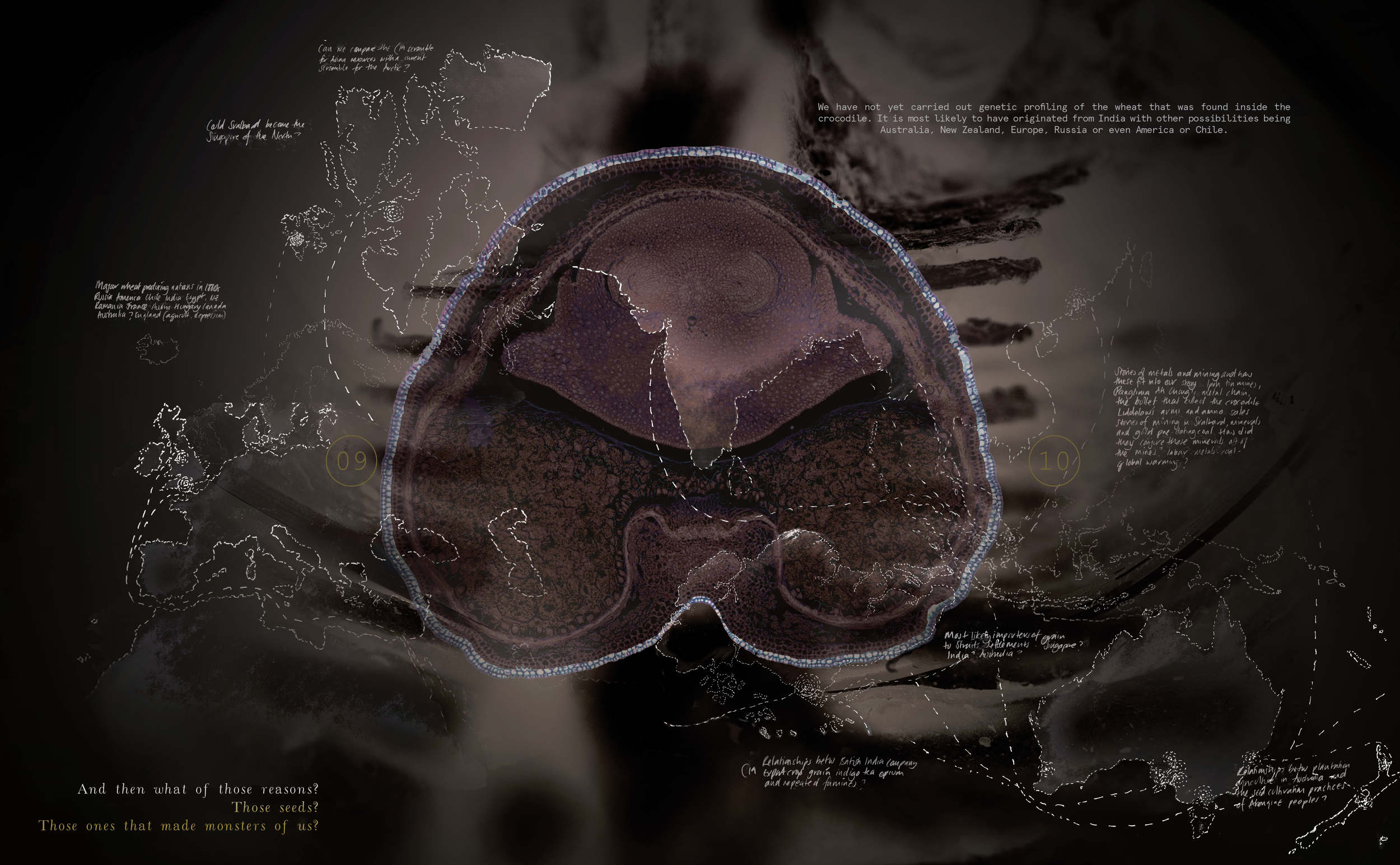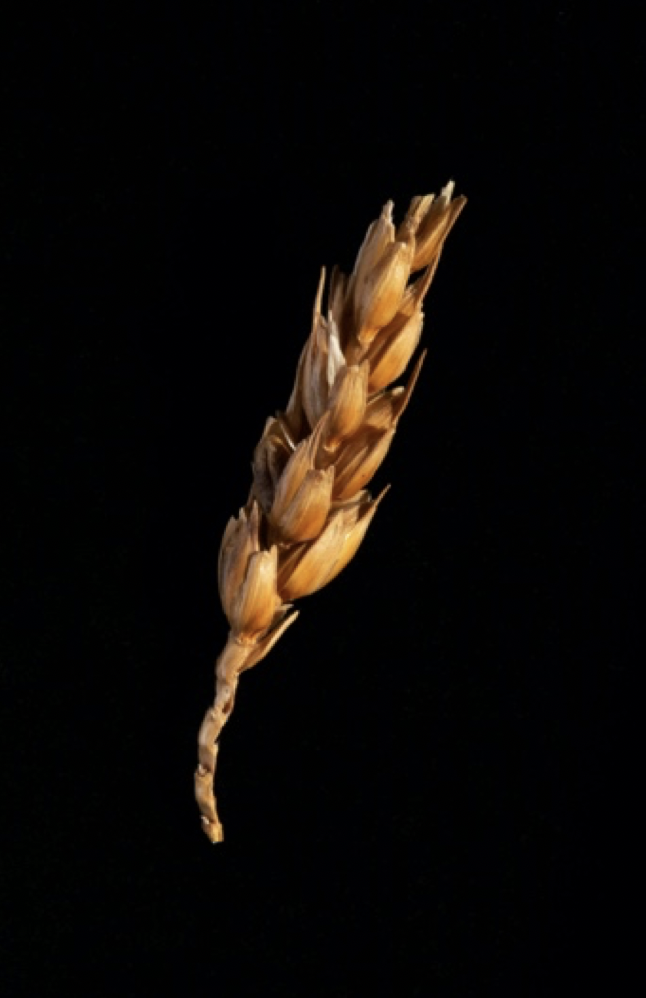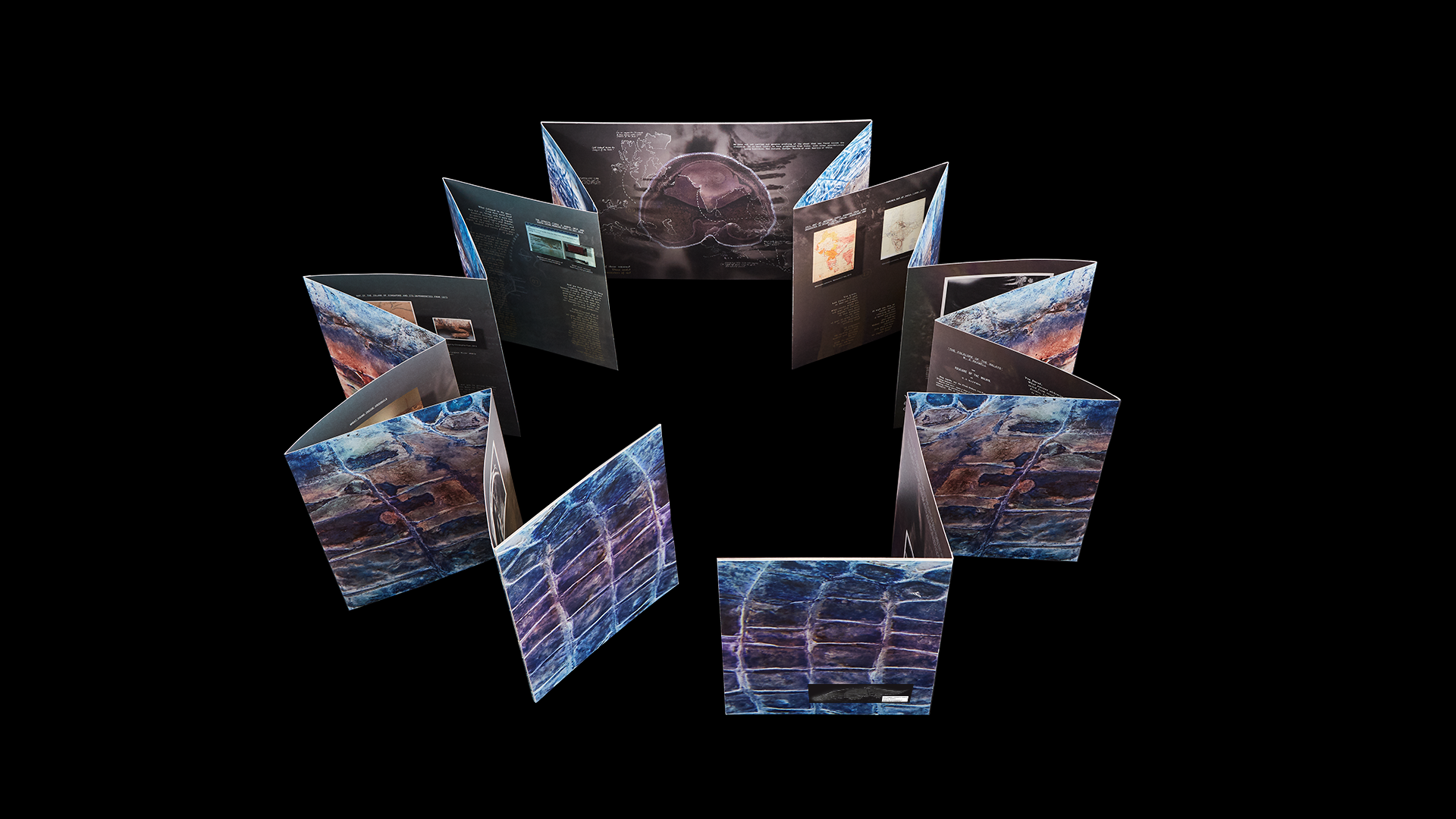About
Seeding Stories: A Guide To The Interior Of A Salt Water Crocodile

Wheat Grain World Dreams by Zachary Chan and Lucy Davis, June 2019. Background photograph of the interior of our crocodile by Kee Ya Ting, 2013. Singapore.
On 10 June 2019, a single grain of wheat, part of wheat-straw stuffing of a 133-year-dead, 4.7 metres long, saltwater crocodile, shot in 1887 at the mouth of the no-longer-existing Serangoon River, Singapore and kept for over a century in the Raffles Museum, migrated to the Arctic circle and was ceremonially buried in Platåberget, adjacent to the Svalbard Global Seed Bank, on the Norwegian island of Spitsbergen.
This gesture was part of an artwork by the Singapore-situated Migrant Ecologies Project. The work was selected by an international jury of artists and scientists from 100 entries from all over the world for an exhibition curated and led by Dr. Fern Wickson from the Centre for Biosafety at University of Tromsø – The Arctic University of Norway. Dr. Wickson believes that nature and human cultures are intertwined and wanted to generate a parallel initiative to remember 21st century cultural relationships with plants and seeds, next door to the world famous doomsday vault.
This gesture was part of an artwork by the Singapore-situated Migrant Ecologies Project. The work was selected by an international jury of artists and scientists from 100 entries from all over the world for an exhibition curated and led by Dr. Fern Wickson from the Centre for Biosafety at University of Tromsø – The Arctic University of Norway. Dr. Wickson believes that nature and human cultures are intertwined and wanted to generate a parallel initiative to remember 21st century cultural relationships with plants and seeds, next door to the world famous doomsday vault.

The one grain we were able to find in the crocodile-straw in 2019 was inside this husk. The kernel is on the bottom row, second from right. Photograph by Kee Ya Ting Singapore, 2019.
The Migrant Ecologies Project proposal was called Seeding Stories: A Guide to the Interior of a Salt Water Crocodile. It is one part of an ongoing research initiative that started in 2013 and was first exhibited during a project called Unearthed at the Singapore Art Museum.
For this iteration of the work, Migrant Ecologies Project artist Zachary Chan travelled (carbon costs were offset) to Svalbard with this very special grain of wheat and a series of other artistic offerings from the Migrant Ecologies Project for a ceremony, in which the works were offered to the mountain and placed to rest in Gruve/Mine 3, next to the Svalbard Global Seed Bank.
Our proposal consisted of regarding this 133-year-dead, saltwater crocodile as a comparative seed bank to the Svalbard Global Seed Vault.
But equally important for us has been the discovery, initially by Kate Pocklington (currently Curator at the Lee Kong Chian Natural History Museum) of what has become a feral diversity of sources all claiming in different ways that this very crocodile (currently in the Lee Kong Chian Natural History Museum) is believed to host the spirit of Panglima (Warrior) Ah Chong, 19th century gangster, Taoist mystic, and anti-colonial freedom fighter.
How might such disparate beings as a wheat grain, a crocodile, and a spirit being, all entangled in the legacies of colonial agro-economies and monstrous dreams of progress, speak to the Svalbard Global Seed Vault in a time of mass extinction and climate change?
Singapore and Svalbard are two islands situated in radically different parts of the globe.
There was, as we know, a violent scramble for natural resources by colonial powers from which Singapore emerged as entrepôt trading post in the 19th and 20th century. And the emergence and increase in attacks by saltwater crocodiles throughout our region can be seen as an ongoing result of the devastating impact of colonial and postcolonial capital on coastal ecosystems.
There is also a potential equivalent scramble for the Arctic commencing right now as China, Russia and America all compete for the precious minerals and sea routes that are being uncovered as the ice melts. Incursions by polar bears into the town of Longyearbyen are also on the rise.
Might Svalbard become the Singapore of the 21st century? And if so, what kind of worlds might this new entrepôt inherit?
Some artist pages and photographs taken in Svalbard and Singapore at the time of this project, were published at the time in the Southeast Asian contemporary art publication ArtsEquator.
A 4.7 metre long concertina artist’s book was also deposited in Gruve/Mine 3. (photograph below) A copy of this book can be downloaded here.
For this iteration of the work, Migrant Ecologies Project artist Zachary Chan travelled (carbon costs were offset) to Svalbard with this very special grain of wheat and a series of other artistic offerings from the Migrant Ecologies Project for a ceremony, in which the works were offered to the mountain and placed to rest in Gruve/Mine 3, next to the Svalbard Global Seed Bank.
Our proposal consisted of regarding this 133-year-dead, saltwater crocodile as a comparative seed bank to the Svalbard Global Seed Vault.
But equally important for us has been the discovery, initially by Kate Pocklington (currently Curator at the Lee Kong Chian Natural History Museum) of what has become a feral diversity of sources all claiming in different ways that this very crocodile (currently in the Lee Kong Chian Natural History Museum) is believed to host the spirit of Panglima (Warrior) Ah Chong, 19th century gangster, Taoist mystic, and anti-colonial freedom fighter.
How might such disparate beings as a wheat grain, a crocodile, and a spirit being, all entangled in the legacies of colonial agro-economies and monstrous dreams of progress, speak to the Svalbard Global Seed Vault in a time of mass extinction and climate change?
Singapore and Svalbard are two islands situated in radically different parts of the globe.
There was, as we know, a violent scramble for natural resources by colonial powers from which Singapore emerged as entrepôt trading post in the 19th and 20th century. And the emergence and increase in attacks by saltwater crocodiles throughout our region can be seen as an ongoing result of the devastating impact of colonial and postcolonial capital on coastal ecosystems.
There is also a potential equivalent scramble for the Arctic commencing right now as China, Russia and America all compete for the precious minerals and sea routes that are being uncovered as the ice melts. Incursions by polar bears into the town of Longyearbyen are also on the rise.
Might Svalbard become the Singapore of the 21st century? And if so, what kind of worlds might this new entrepôt inherit?
Some artist pages and photographs taken in Svalbard and Singapore at the time of this project, were published at the time in the Southeast Asian contemporary art publication ArtsEquator.
A 4.7 metre long concertina artist’s book was also deposited in Gruve/Mine 3. (photograph below) A copy of this book can be downloaded here.

Photograph by Kee Ya Ting, Singapore, 2019
A continuation of this research involves the genetic profiling of other wheat grains that have since been found inside the crocodile straw as well as a series of other seeds and flower heads that appear to have been harvested alongside the wheat.
A team of artists, musicians and historians brought together by The Migrant Ecologies Project and curator Sidd Perez from NUS Museum, will also be undertaking research in among other things, Taoist sites dedicated to Pang Limah Ah Chong, in Ipoh and Taiping, Malaysia in 2020.
A team of artists, musicians and historians brought together by The Migrant Ecologies Project and curator Sidd Perez from NUS Museum, will also be undertaking research in among other things, Taoist sites dedicated to Pang Limah Ah Chong, in Ipoh and Taiping, Malaysia in 2020.